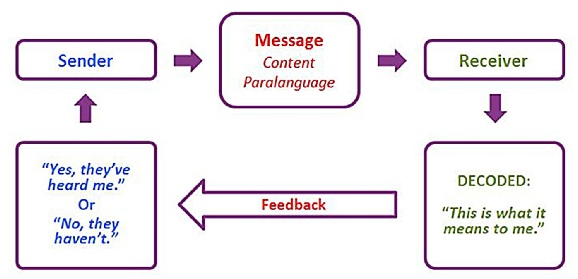Write On The Beach © Sheila Williams Website Design © Write Good Books Write Good Books

Do You Understand Me?
Communication is the essence of human relationships. It’s a 2-way process - an exchange and all who participate need to check for understanding. Have a look at this diagram of a communication cycle.
The Communication Cycle
One of you (the sender) communicates a message. The message has content – usually what you want to say - and paralanguage, which is the way you deliver your message (the emotion or tone, pitch, pace, visual cues).
The receiver takes your message and decodes it. They then acknowledge your message in some form so that you get feedback; that leads you to believe that either they’ve heard and understood you or not, as the case may be.
This holds true for any form of communication with any one, be it your partner, a customer or the bank manager. The potential for communication to go wrong lies at the decoding stage and the feedback stage.
The feedback stage is often the one missed out or maybe just gets a grunt of acknowledgement. It is often the point at which assumptions creep in. You assume that your listener heard you and understood what you’re talking about and so you don’t check to be sure. A simple final query such as: “So we’re agreed then…?” or “So you’re saying that…” can go a long way to making sure you are both singing from the same song sheet.
How your listener decodes your communication depends on a whole host of other issues, for example: how clear you have been, how you have delivered your message, their knowledge about the subject, their interest in it, their feelings about it and about you, what else they are doing at the time. Your preferred style of communication is one of the main factors affecting receipt and understanding of your message. Here’s a brief example.
A friend of mine had a tiff with her new partner recently. They were driving north, up the M1 from Sussex. About halfway, my friend said to her partner, “There’s a service station coming up, do you fancy a coffee.” To which he replied, “No thanks, I’m fine.” She said nothing more, but on reaching home went off in a bit of a huff. He, wondering where he’d gone wrong asked her about it. She replied that she had really wanted to stop for a coffee and was annoyed because he’d refused. “I didn’t refuse,” he protested,” I just said I didn’t want one. You didn’t tell me that you did.”
My friend has an indirect communication style and her partner a direct one. Knowing when and where to use these two styles can make all the difference to your interactions.
Direct Communicators tend to have a straightforward and open style. Their meaning is explicit - they “tell it like it is” – and they are more likely to “tell” rather than “ask”. Often, they communicate without worrying about timing, place or emotional situation. They come across as confident and self-possessed. Their particular strengths lie in bringing issues and problems out into the open and in leading and taking charge.
When you hear direct speech, you know immediately what needs doing. There is no question about who is in charge, and usually no need for discussion. Direct communication is often necessary in the workplace and there are times when it is the only appropriate option. For example when:
you are the expert and can be clear about your knowledge of the topic;
there is only one right way to do something and/or the outcomes are subject to law, policy, safety or discipline;
you're short on time and something needs to be done immediately;
The listener is unaware of the need to do something or seeks help in doing something.
The direct communicator can appear authoritarian, argumentative and sometimes downright rude. An overuse of the style may lead to disengagement, lack of cooperation and disempowerment.
Indirect Communicators communicate in a more roundabout way including suggestions, implication, use of non-verbal behaviour and other cues. They come across as quite modest and approachable. They are normally good listeners.
The indirect style is not typically authoritative yet is very useful in appropriate situations. For example when:
your listener is the expert and you want to learn from them;
commitment to a course of action is critical or you want to create collaboration, synergy and ownership;
You want someone to learn through involvement.
Indirect communicators can appear vague, beating around the bush expecting their listeners to read between the lines. An overuse of the style may give the impression of deviousness and being untrustworthy.
Neither style is specific to gender nor is one style in any way better than the other – just different. My indirect friend used her natural style to suggest that a coffee would be good – with a subtext of “I’d like a coffee now”. Her new partner, probably unaccustomed to her style and having a direct style himself, merely thought that she was just asking him if he wanted a coffee. Such misunderstandings can lead to domestic and workplace dust-ups.
So take a moment or two to consider how your family, friends and work colleagues interpret your communication style.
First published in my coaching column in The Health Service Journal
